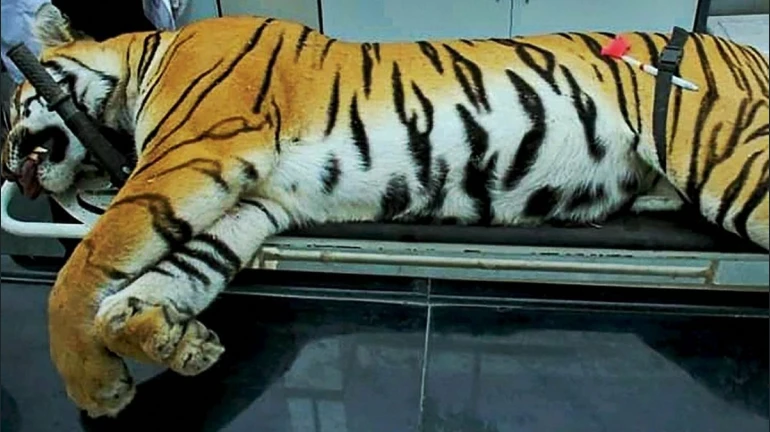
Tigress Avni who was also known as T1 was termed as an alleged man-eater, killing 13 people in last two years, was murdered in front of her cubs in Yavatmal on November 2, 2018. This year, in September, the Supreme Court ordered to shoot Avni at sight in case of threat or, which prompted a flurry of online petitions seeking pardon for the tigress.
However, she was shot dead by sharp-shooter Asgar Ali, son of a sharp-shooter Nawab Shafat Ali, at compartment no 149 of forest under the jurisdiction of the Ralegaon police station.
Animal activists carried out protests across Mumbai demanding a probe in Avni’s killing and to protect her 10-months-old cubs.
Also Read: Tigress Was Facing Away From The Hunter When She Was Shot: Avni Post-Mortem Witness Report
Meanwhile, the National Tiger Conservation Authority (NTCA) who probed the killing revealed that drugs used for the tigress were handled by non-professionals and personnel.
From the reconstruction of movement of T-1 (Tigress Avni) and final position of the body of T-1, it was moving away from the road and vehicle on its traditional walk path while it was shot. Tigress was not aggressive and showed behaviour that was natural after it was hit by a dart, and they were moving towards the direction of the animal. Tiger's reaction was mistaken and the shot was taken in a hurry by inexperienced Asghar Ali Khan. Evidence strongly supports above observation. In view of the facts, the firing in self-defence is doubtful," the report highlighted.
If we speak of Mumbai, no leopard has been termed as man-eater but animal-human conflicts is a common case in the city. Activist Pawan Sharma of Resqink Association for Wildlife Welfare (RAWW) believes that encroachment is not the sole reason but one of the reasons for animal-human conflict.
Our forefathers have been staying with animals. The interaction between wildlife animals and human is the best exercise. But, there are all sets of people. Some don’t mind to co-exist with animals but some create panic. And considering the development growing at the fast pace, conflict is likely to increase,” said Sharma.
Awareness is the need of an hour, added Sharma. He referred a case that took place a few years ago when a leopard attacked a man in Rahul Nagar of Mulund when he tried saving his dog.
Post Rahul Nagar's incident, we tried sensitising people with the help of forest department officials. We carried out camera tapping exercises and regular patrolling was also carried out. I believe that only forest department officials cannot come out with a solution. Rahul Nagar being an encroached area, the state should rehabilitate people and let animals live where they belong,” he added.
He admitted that rehabilitation is not easy but not impossible.
Surve, Research Consultant with Wildlife Conservation Society-India (WCS) took spoke on the conflict that took place in Sanjay Gandhi National Park (SGNP).
Mumbai has a history of animal attacks, some were fatal. Last year, one leopard injured six kids and killed one. He was rescued and was kept in a rescue centre. After 2013, attacks have decreased. Sanjay Gandhi National Park comes under wildlife wing of forest dept while Aarey comes in territorial wing of forest dept. Thane territorial division and Mumbai forest department have a good rescue team and both departments are good in rescuing leopards. This January, we rescued leopards from Nanepada, Mulund and in the month of June, we rescued one in Marol, far away from the park. We found one in a person's bedroom where he was rescued in three days,” said Surve.
Statistics of leopards found in SGNP
2015 counted- 35 leopards
2017- 41 leopards
Areas- SGNP, Aarey, Powai
Surve added that the people should take precautions during dark hours and should understand that leopards don’t avoid human settlements, they avoid humans. He added that people have become more sensitive regarding animals as they call animal activists and ask them to rescue the animals in need.
Also Read: Two Committees Formed To Probe Tigress Avni’s Killing
Meanwhile, Tito Joseph, Programme Coordinator, WPSI mentioned how poaching cases, road accidents, and human-animal conflicts have increased and is destroying the habitat of leopards.
Maharashtra saw the second-most leopard deaths (90) in the country in 2018, while Uttarakhand topped the list with 93 deaths, according to the year-end data collated by a Delhi-based wildlife group, Wildlife Protection Society of India (WPSI). India had recorded 431 deaths in 2017, 440 in 2016, 399 in 2015 and 331 in 2014.
I believe that it is high time, when we, humans, should stop encroaching into spaces that are meant for animals. In the name of redevelopment, we are not only violating wildlife norms but are putting animals’ lives at risk as well. Henceforth, if any of us who reside in their spaces should not cry over the loss of our pet or any other stray animal. We are supposed to live off their boundaries.





